
A shoal of Michael Fish
As requested by David Rankin

A shoal of Michael Fish
As requested by David Rankin
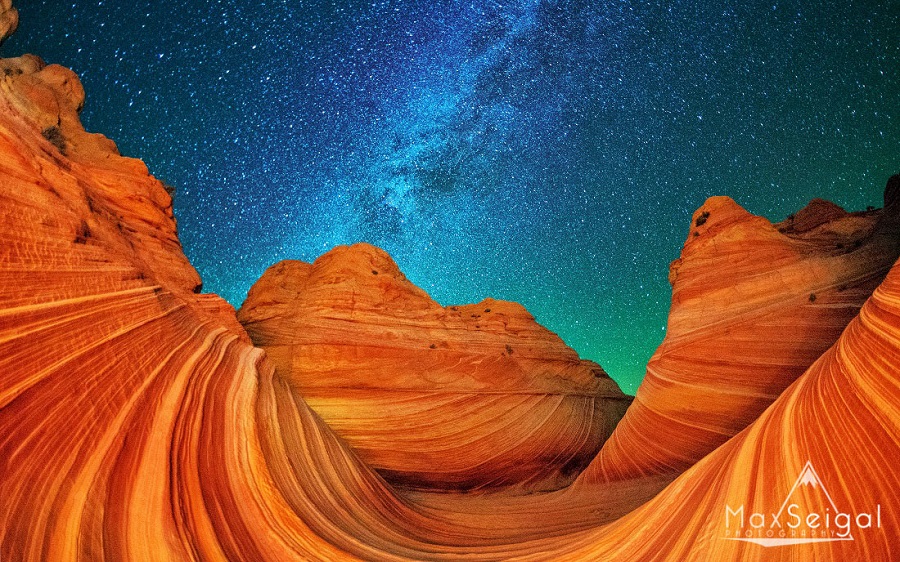

In this post Max Seigal (www.maxwilderness.com) will talk about his night photography:
It was the most difficult shot I’d ever created. I sat, huddled in the cave, wondering if the stars would ever creep out on that cloudy night. It was the Milky Way, after all, that I was hoping to photograph that night, while light painting the kiva in the foreground. Midnight…still no stars… 1am, 2am… then I hear something in the distance. Thunder. I look out, hoping my ears had deceived me, and there it was. A bright flash of lightning, miles away, crashing over distant canyons. The first thought that came into my mind – panic. Here I was in a very remote location in Canyonlands National Park, alone in the darkness of night, and a massive thunderstorm was rolling in my direction. Did I have enough time to pack up my gear and run to my car? I waited for the next bolt of lightning, which flashed only moments after the first but seemed much, much closer than the first. The storm was moving fast, there was no way I could outrun it. I had to stand my ground and wait it out.
The raindrops started trickling around the edge of the cave, then with almost no warning, rain and hail smashing everywhere, and lightning crackling almost directly overhead. It all happened so suddenly, this storm was moving incredibly fast. The wind picked up and started howling, blowing sand, dust, rain, and hail all over the place. My camera was already on its tripod, so I figured I would open the shutter just to see what happens as I curl into a ball to stay dry. I knew the intensity of the lightning would require a much lower ISO than usual for my night shots, so I dropped the camera all the way down to ISO-400 (usually I stay around 6,400 for night shots), and stopped the lens to F5 (usually I’m at 2.8). I had no idea if these settings were appropriate, as I’d never tried taking photos from the middle of a lightning storm before.
Suddenly there was a massive crack of lightning a few miles out, so bright that it lit up the canyon light it was daylight. I jumped up from where I was huddling up, and I knew that if I had any shot to make this photo work, it was now. I grabbed my flashlight, and began light painting the cave. Usually just a few seconds of light is enough, but with my camera all the way down to ISO-400, I quickly calculated that I would need several times the average amount of light needed to paint at night. I was running left and right, painting everything I could, trying to remember how much light I had applied to different areas in the cave so that the exposure would come out evenly. I had no idea if this was going to work… I had never tried anything like this before! Finally I turned off my flashlight, crossed my fingers, and clicked the shutter closed. I held my breath and clicked the review button on the camera. Unbelievable!!!! The shot was more amazing than I ever could have imagined… what a reward for such effort to capture the shot.
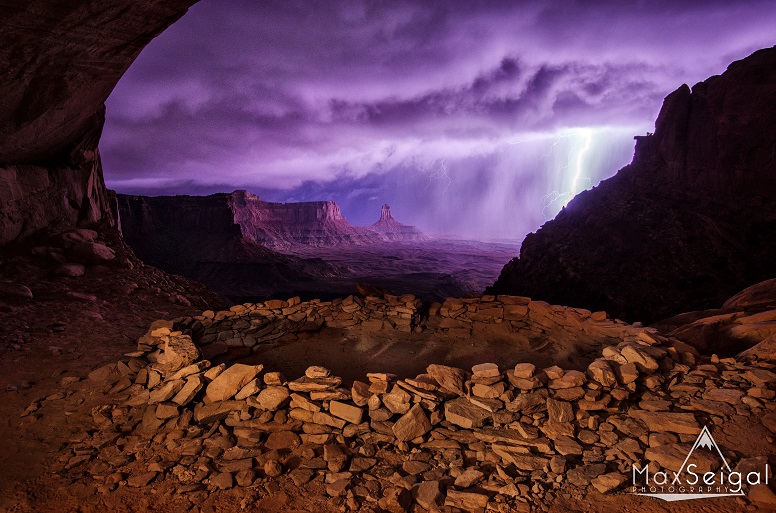
This photograph would later on win second place in the 2013 National Geographic Traveler photo contest, which received over 15,000 entries this year.
AN HOUR AFTER SUNSET, most photographers are packing up their gear and heading to a nice hot meal and a warm bed, but not me. I’ve waited all day for the sun to dip over the horizon, and now it’s time to grab my camera bag and start hiking.
Typically, I will scout a location during the day, looking for unique angles, perspectives, and subjects to shoot, with a vision in mind of how it will look at night. I examine the subject: will I be able to illuminate it with a light (like a tree, for example) or is it too far away or too difficult to light, in which case it’ll remain completely black in the photo (for example, a distant canyon or desert tower)? Next, I think about how I’ll compose the photo during the dark of night. A composition that looks great in the sunlight isn’t necessarily one that works at night. Then, I think about how the lighting will affect the subject, where the Milky Way will be in relationship to the subject, at what angle the moon will appear (if at all that evening), where light pollution from nearby cities might show up in the photo, and countless other elements that don’t need to be accounted for in your standard daytime travel photography.
Finally, there’s the matter of actually finding the subject you scouted during the day. Imagine you’re walking around a vast desert and spot the perfect tree in the distance. It’s guaranteed to make a memorable night shot — but it’s still a lone tree in a wide-open desert. The second the sun goes down and you’re walking around in pitch black with a headlamp that only gives you a 10′ visual in any direction, the simple act of finding that tree might well be the most challenging task of the night.
There are so many factors, so many challenges that come into play with night photography, that when you finally do capture the perfect night shot, it’s that much more rewarding.
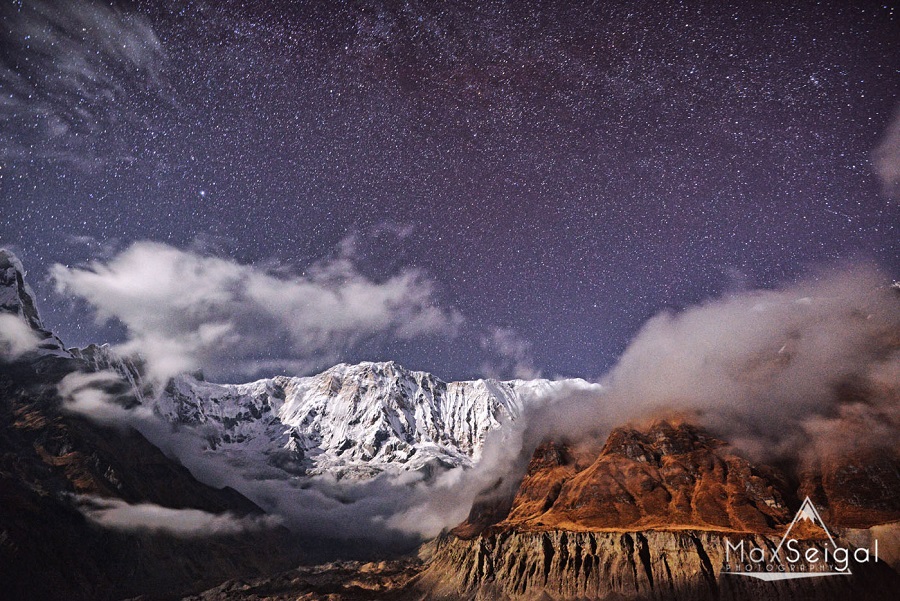
This photo was taken from Annapurna Base Camp in Nepal. I spent the night standing outside in sub-zero temps, waiting for the moon to be at just the right angle to illuminate the massive 8,167-meter peak. Here, the only reliable form of illumination for the landscape was the moonlight. On a moonless night, the mountains would have been lost: black silhouettes against the starry night in the background.
As I was shivering for hours in the cold dark night, I had to do jumping jacks between shots to keep warm. I accepted it as part of the dedication required to get the great night shot above.
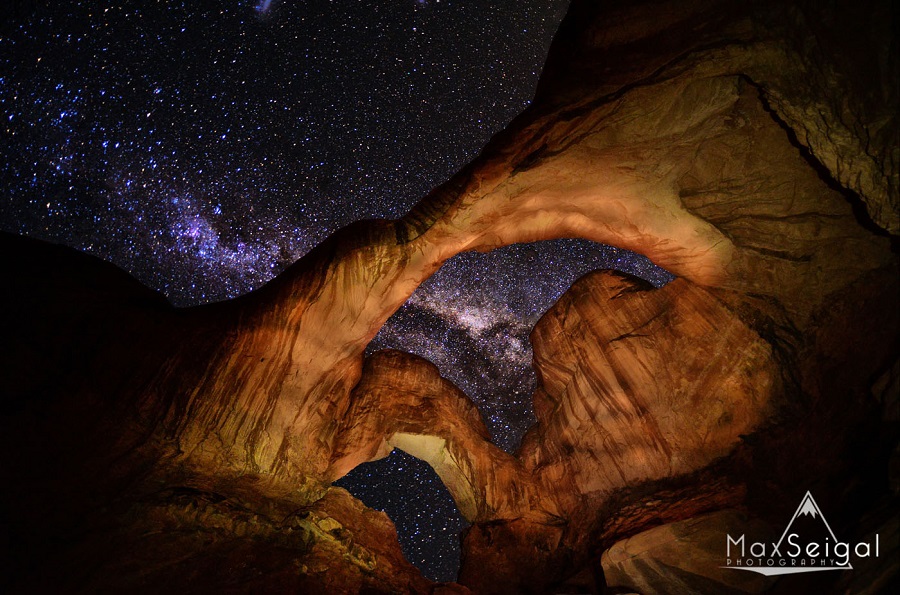
This shot was taken at Double Arch in Arches National Park, Utah. The particular formation was difficult to illuminate evenly because the top of the arch reaches 148 feet high. Its height means it requires significantly more light painting at the top than the lower portions of the arch to achieve an even spread of light.

I spent several days hiking around Fitz Roy in Chile in search of great night photography locations. I stumbled on this tree halfway up the eight-mile trek to the mountain’s base. I knew it was going to be a challenge finding the tree in the night, so I made sure to memorize nearby landmarks to help find my way.
At midnight, I started hiking and quickly realized it was a terrifying experience to try to keep track of the tiny footpath that wandered through the woods for miles, alone in the dark. After about two hours, I finally began to recognize the landmarks I’d memorized earlier in the day and managed to capture one of my favorite night sky images to date.
There are several techniques for night photography — some more pure and natural than others. While many of my shots only incorporate natural features of the landscape, I wanted to add a human element to this night shot. The idea in my mind represented the symphony of man and nature, the integral relationship between us and the natural world we live in and the interconnectedness of mankind with our environment.
I searched long and hard for a subject that could portray this message. The tree I found, shaped by years of relentless winds on the rim of the Black Canyon in Gunnison, was perfect for the shot.
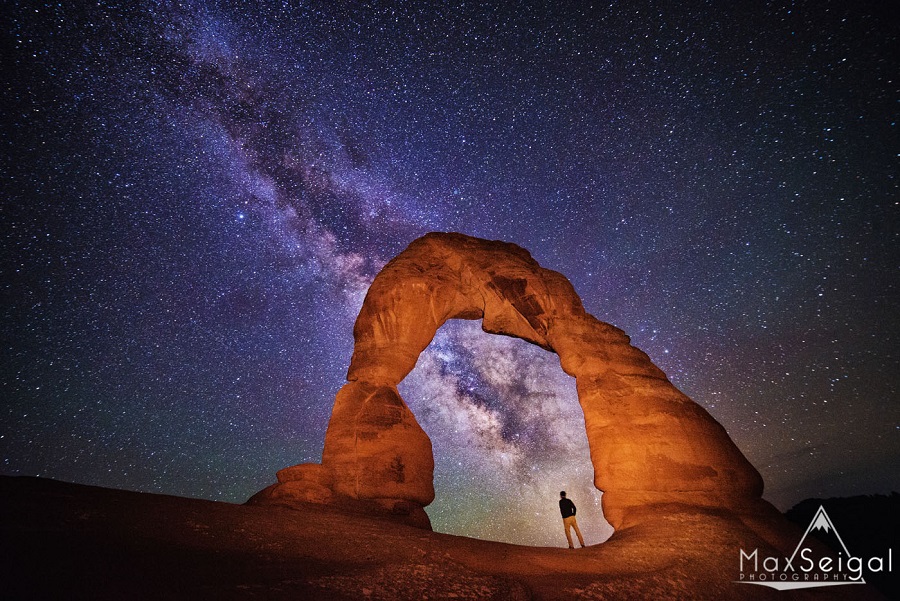
Sometimes everything comes together and no amount of planning could have created a more perfect photograph. I spent the night photographing Delicate Arch in Utah, getting images of the arch in contrast with the Milky Way behind it. As I was just about to leave, I thought it would be fun to get a self-portrait in the setting I love most — outdoors, lost in the vastness of nature and night. I set up my camera and light, set off the trigger, and quickly ran under the arch to stand for this image.
I had no idea how it would turn out, but when I returned home and downloaded the image to my computer, I saw that everything had come together by chance to create this compelling night shot.
More fun shots at night:
Perseid meteor shower. For this image, I took several shots during the night, and those frames that captured a meteor, I merged together to get a composite of the night.

Full moon rising behind Mt. Bearhat in Glacier National Park
Most of these images were made with the D600, a camera who's low light capabilities really surprised me. A range of lenses were used, including Sigma 15mm fisheye, Rokinon 14mm 2.8, and the Nikon 16-35mm f4.
More work can be seen at Max Seigal’s website: www.maxwilderness.com.
If you have an interesting idea for a guest post, you can contact me here.
Posted by NikonRumors.com
This RSS feed is copyrighted and cannot be republished in any way without permission.
Follow [NR] on Facebook and Twitter.
Related posts:
Simple SimonNope!
These days, we’re all about customization, and Flex Shelf, designed by Story Store, gives you exactly that. Not only does it provide storage for your books, you can even turn the shelves into words or little drawings – whatever your heart desires!
It’s made up of modules that are different lengths that can be put in any combination. The modules also come in different colors (9 total) to fit your mood.

One of the first Merckx Monday posts I ever made was on Eddie’s Hour Record track bike. Go back and check it out if you missed it. When I saw this artwork by Richard Pool, I immediately thought of that beautiful machine!
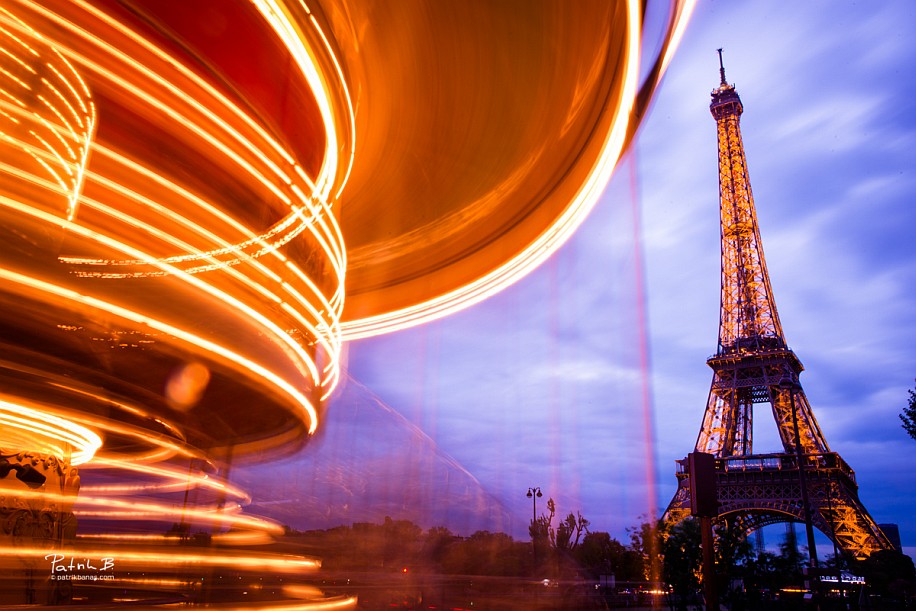
The guest post "Different angles of Mademoiselle Eiffel" is by Patrik Banas (Web | Blog | Facebook):
If you have only a limited opportunity to take pictures during your occasional travels, do not hesitate and take this as a possibility to train your eye, find more angles, try something new… aka “work it, work it, work it”. Even one and very same object, can be taken in the numerous different ways. Let me share examples from my summer, very short trip to Paris.
When you are visiting Paris, you can't miss Eiffel tower. It is really visible from almost everywhere! Obviously I have taken few nice classical "postcard shots" as well (they will come later!), but let me first start with THE tower from some different, a bit unusual angles.
This one has been taken next to a small carousel. And as I LOVE the motion in the pictures, I had to incorporate a carousel into the frame. Mind a beautiful sky - all brought by favorite dusky FLW filter, otherwise picture is almost straight out of the camera.
Unfortunately, majority of the tourists in Paris had the same clever idea about the "visit to the top" of the tower – to come early in the morning for the opening (9.30am)! That’s why queuing line looked never ending. Total time from the beginning of the line to the top and back was five hours! All other activities for that day were cancelled... However, during climbing up I was at least exploring different angles. Still the same tower, but I was frankly amazed, how many opportunities I could find! Work it, work it, work it…
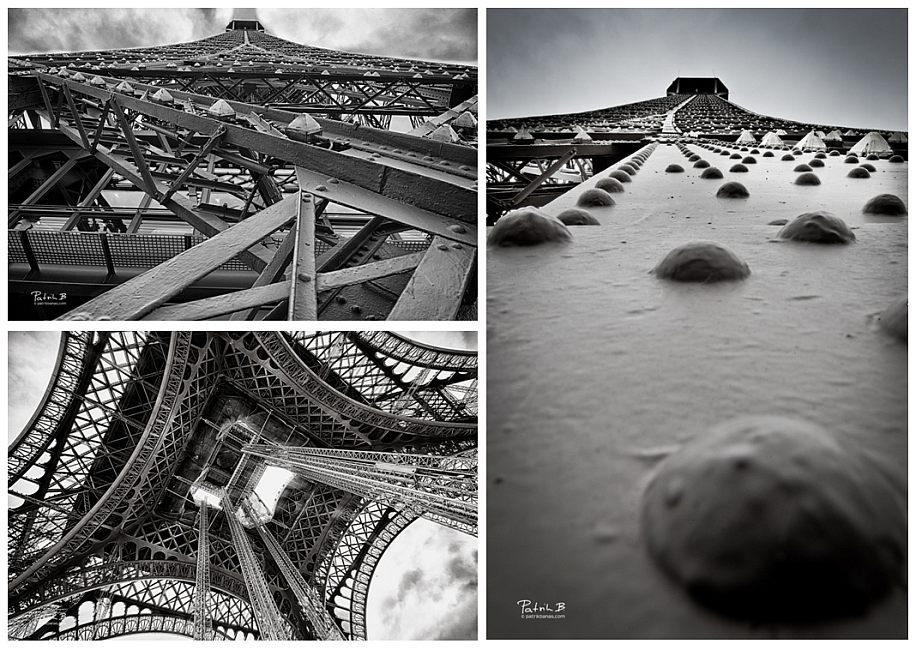
Ok, now we are getting to a more "postcard" version of the Eiffel tour. As you can see, it was a very cloudy day, and about an hour prior to the dusk I was blessed with a 5 minutes of gold sunshine rays. This has been captured in this HDR composite - heavy clouds above the city and a slight moment of the sun greetings, just above the horizon. But trust me, this is still not THE postcard one.

The following picture has been taken just 5 minutes after the one with carousel, about 500ft away. On the way to the top of Trocadero stairs I have noticed this unusual angle and situation, where the tower would appear like growing from the bushes. Obviously, bushes were pretty dark on the picture, just a silhouette of it.
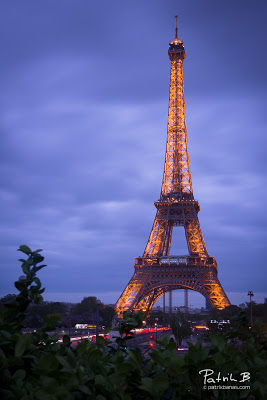
So my Nikon DB-900 flash came handy and during a 20 sec exposure I have fired manually a simple burst to lighten up the foreground in front of me and achieve a sense of the tower nested in the green. Final result really surprised me and I had another shot to my collection of the same subject.
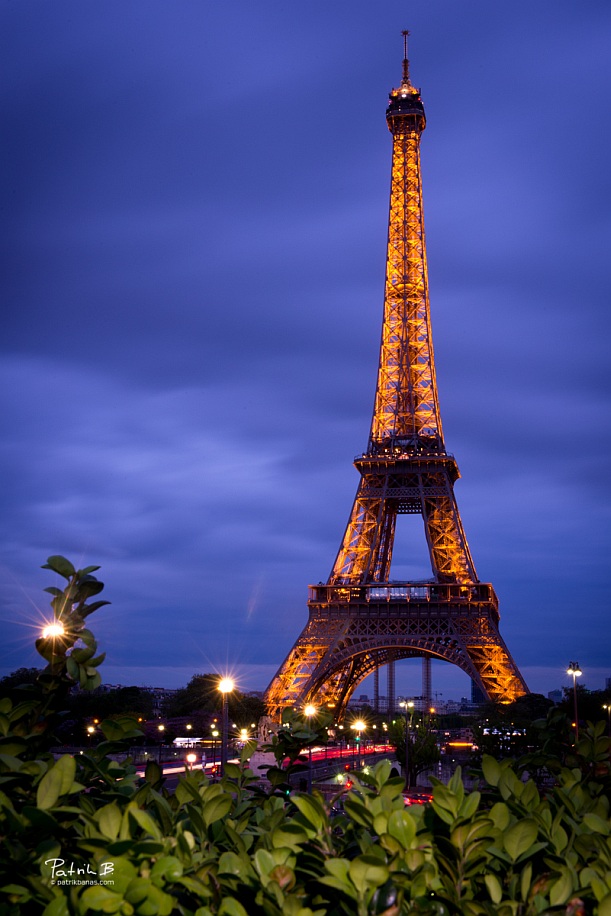
Nikon D800, 24-70mm at 42mm, f/22 @ 20sec, ISO 100. Nikon SB-900 fired off the camera with a ¼ of the power and within about 1m (3ft) distance.
Enough teasing. Here it comes. The most classical Eiffel tower view, the most classical postcard shot. Something you HAVE to shoot on your own, otherwise it doesn't count and you were NOT in Paris ![]() Well, mademoiselle Eiffel is very photogenic, no doubt about that. And her illuminated, curvy shape against a dusky, cloudy and colorful sky has no competition in Paris. So here I was. After playing enough with a carousel and flashes, I am arriving to the top of Trocadero square and I am fighting elbow to elbow with all other photographers and thousands (literally!) tourists to get the best available position. Keeping an eye (other one, which wasn't glued to the viewfinder) on roaming individuals who had a tendency to kick my tripod (yeeah, and this is not something you want at the end of your 20 sec exposure!
Well, mademoiselle Eiffel is very photogenic, no doubt about that. And her illuminated, curvy shape against a dusky, cloudy and colorful sky has no competition in Paris. So here I was. After playing enough with a carousel and flashes, I am arriving to the top of Trocadero square and I am fighting elbow to elbow with all other photographers and thousands (literally!) tourists to get the best available position. Keeping an eye (other one, which wasn't glued to the viewfinder) on roaming individuals who had a tendency to kick my tripod (yeeah, and this is not something you want at the end of your 20 sec exposure! ![]()
When is the best time to shoot a vertical picture? Right after the horizontal one! And once you are there, milk the situation and try to get "close ups" and details too. I've personally really enjoyed getting the maximum out of few minutes of the magic light. Have fun too, have a wonderful exploring time and … work it, work it, work it! ![]() And of course, enjoy your holidays!
And of course, enjoy your holidays!
This Eiffel session you can find on my blog here.

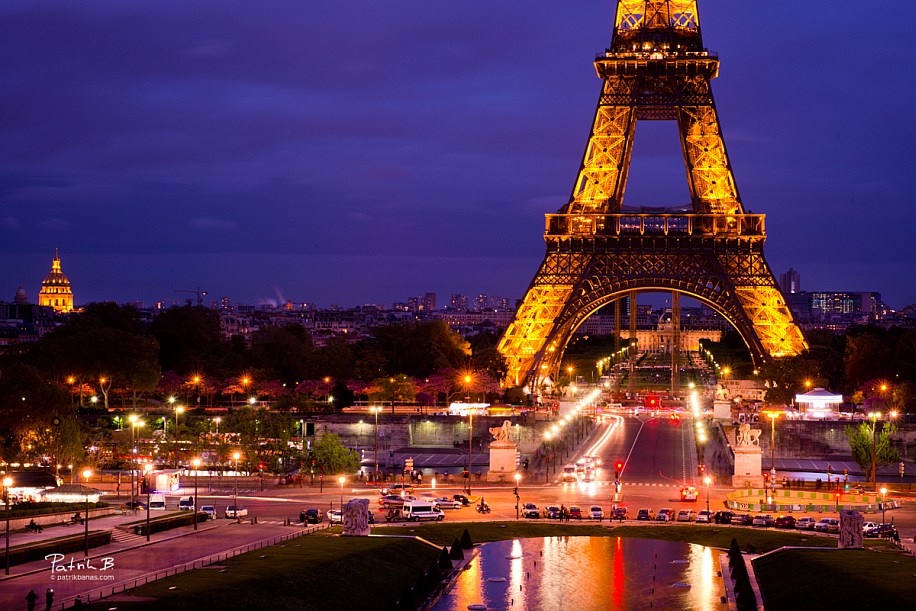
Patrik is an enthusiastic Nikon photographer, who loves to travel and explore the world through his lenses. You can meet him at his website, blog or follow him through facebook.
If you have an interesting idea for a guest post, you can contact me here.
Related posts:
I couldn’t help myself:
At CES, Audi introduced a laser-beam powered headlight concept that will have you forgetting you ever wanted those Xenon ones. The Laserlight concept, which was being shown on their Sport Quatto, uses LEDs for the low beams and then switches to laser diodes for the high beams. Although no specific timeframe was quoted, Audi’s expecting that these will be used on a future production vehicle. We’re pretty excited, especially since these apparently they are able to light the road for up to 1/3 mile and are three times brighter than LED headlights. Plus, lasers.
Simple SimonThe first video (pretty cool) is in the shopping Mall just opposite my brother's house in KL! I've eaten in the Social :)

When you step into a pool of water, you fully expect your foot to fall right down to the bottom, unless you’re under the delusion that you’re the savior of mankind. But if that water has just the right mix of cornstarch in it, you’ll just sort of bounce along the surface. Film company WeAreKix teamed up with Mach by Hong Leon Bank to fill a pool with 8,000 liters of non-Newtonian fluid for an event that makes science fun.
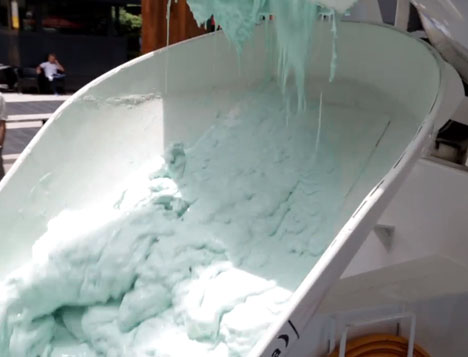
A slight blue tint to the fluid makes the illusion more complete; it really does look like a pool of cloudy water until you witness the surreal sight of someone trotting along the surface like it’s no big deal. Of course, you have to tread lightly and quickly, or you might actually break through and get sucked into the sticky fluid like the little kid in the video.
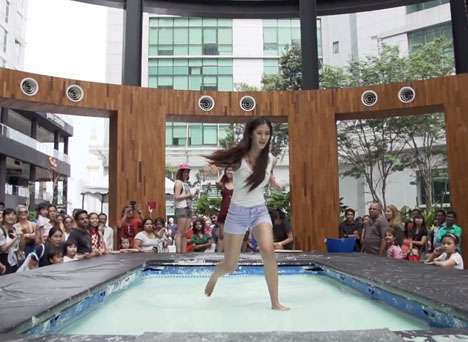
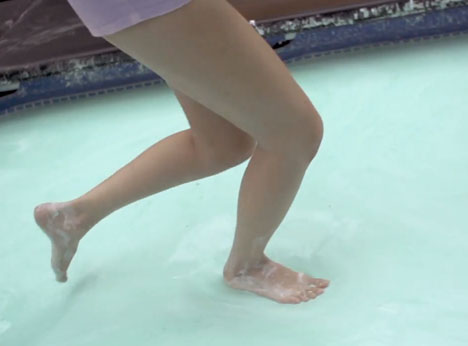
The event took place in Kuala Lumpur and offered a party-like environment to explore the science of non-Newtownian fluid. Visitors ran, jumped and even rode their bikes across the surface of the pool.
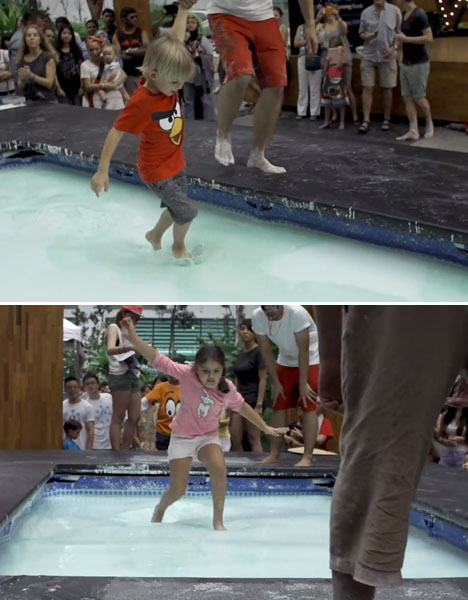
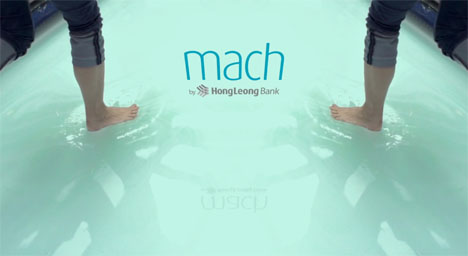
Mythbusters carried out a similar experiment, trying out all sorts of possibilities before settling on non-Newtowntian fluid made with 1,000 pounds of cornstarch.
Bonus feature: liquid mountaineering – the art of skipping like a stone on the surface of the water, using special shoes to get extra steps before you slip below the surface.
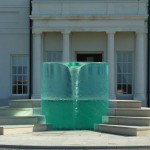
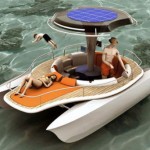
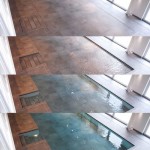




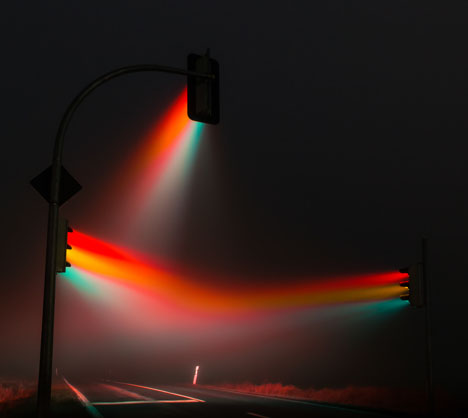
The right place, proper timing and a keen eye conspired to help a photographer capture this eerie nighttime phenomena at a crossroads outside of Weimar, Germany.


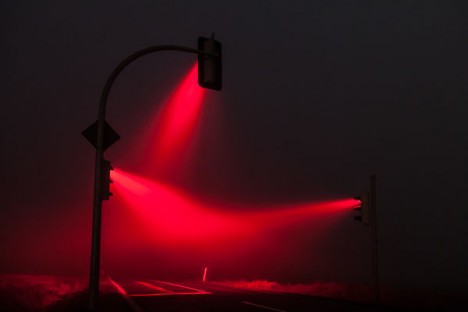
German photographer Lucas Zimmermann found and shot this intersection at each stage of the its cyclical change, capturing green, yellow and red.
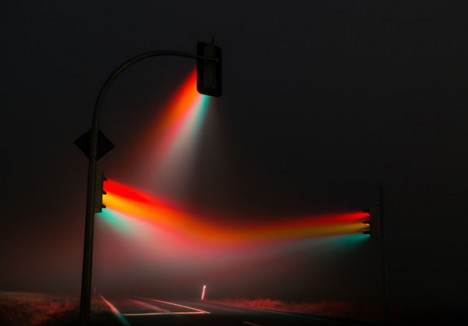
He also went a step beyond the sequential with one particularly impressive shot spanning the entire cycle, creating a rainbow in the mist.
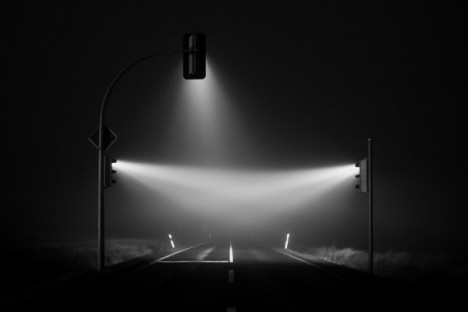
His other work spans from the rural United States to the streets of Beijing, but usually focuses on people over places – this set, however, proved a worthy exception.
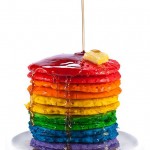
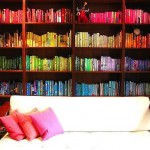
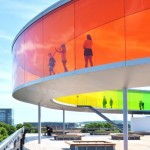




Simple SimonNa na na na na booksheeeelllf
na na na na na na na na na na na na na na na na BATMAAAAAN
I just had to post about this. The Batman bat-shaped bookshelf is a creation of Etsy seller FictionFurniture. It comes in two versions: classic Batman and The Dark Knight. LOVE!
[via This Is Why I'm Broke]
At first glance, these adorable Rainy Pots look simply like a whimsical indoor planter. However, Rainy Pots combines form and function by bringing out childlike emotionality in adults while also keeping the plants happy and healthy. When plants are grown indoors, they often have weak and shallow roots that’s further exacerbated by overloading with water. With Rainy Pots, water is slowly and evenly distributed to the plants without hassle.
Created by Seungbin Jeong, Rainy Pots was a finalist in the 2013 Spark Awards.
Simple SimonSeen this before, but still pretty stunning

What would your city look like if it went completely dark? Words like majestic, awe-inspiring and magical come to mind – not as descriptions for the cities themselves, but how some of their most iconic architecture would look as black silhouettes against the bright starry skies of remote places. Artist Thierry Cohen gives us an idea of just who amazing these visuals would be in his series, ‘Darkened Cities.’

Cohen doesn’t just superimpose random images of the night sky behind each skyline – the imagery is actually what the sky would look like in each of those precise locations. Using methods pioneered by early 19th century photographers, Cohen first takes photos of each location, isolating and darkening the cities themselves, before adding in the sky.

Taking note of the exact latitude, longitude and angle of each city, the artist tracks the earth’s rotation to capture the sky in a place where light pollution doesn’t affect the clarity of the stars, like the Mohave desert.

Pictured here, in order of appearance, are Rio de Janeiro, Shanghai, San Francisco, Paris, Tokyo, Sao Paulo and New York. See more at Thierry Cohen’s website.
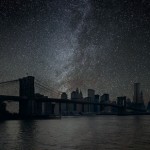
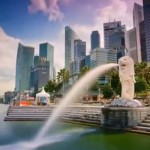
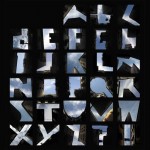





Jim,
Would you kindly draw me Cher riding on the back of the Duke of Wellington statue through Glasgow.
I’d greatly appreciate it. Thanks.
Nicki Fairbairn
Simple SimonCan't go 100% paperless
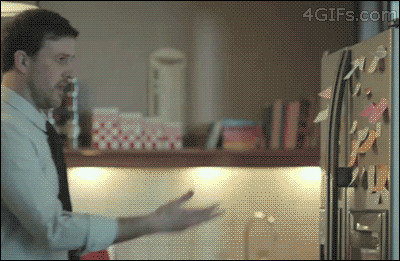
Forget vinyl flooring, Gregor Hildebrandt lays cassette lino at latest New York exhibition.
Berlin-based visual artist Gregor Hildebrandt has unveiled a new exhibition at Galerie Perrotin in New York in which he continues to explore and deconstruct the material quality and emotive potential of analogue sound and video carriers like cassettes, VHS and vinyl. The centrepiece of the exhibition, which sees Hildebrandt continue to use magnetic cassette tape to form the basis of a series of abstract collages, is the creation of his very own Spector-esque “Sonic Wall” built from that most infuriating of vinyl crafts, the crimped record bowl. Here, Hildebrandt has found a much needed alternative use for the junk-sale staple, creating a towering obstacle for visitors to circumvent, consisting of over hundreds and hundreds of the bowls, bought at Berlin’s flea markets.
Elsewhere, Hildebrandt creates curtained walls of VHS tape made entirely out of copies of Wim Wenders’ classic “Der Himmel über Berlin” [Wings of Desire]. Exploring work in which the nature of the recording is as important as the visual impression, Hildebrandt has also doctored recordings of Berlin industrial pioneers Einstürzende Neubauten to form abstract images, made using what he calls a ‘ripping off’ process, explained below:
“The coated side of cassette tapes is put on double-sided adhesive tape, the coat is pressed onto it with a painterly gesture with a brush or a roller, and then the cassette tapes are taken off again. This process can be repeated several times on different canvases, resulting in ever more delicate structures. Finally, the tapes are glued onto a canvas for good. They form the negative.”
Having displayed work at the landmark 2011 exhibition The Record: Contemporary Art and Vinyl in which he exhibited his “Cassette Record” – a 12″ vinyl made up of magnetic cassette tape, Hildebrandt has continued to unwind and explore the possibilities of deconstructing tapes, tiling the floor of one of the gallery rooms with a herringbone parquet floor of empty cassettes, reminiscent of that in his Berlin apartment and not unlike The Vinyl Factory artist Christian Marclay’s site-specific “2822 Records” piece. On the wall above it, he has salvaged 27,000 cassette felts (the pads over which the magnetic tape runs), for a highly conceptual piece entitled “Die Geschichte läuft über uns”, translated either as “The Story Runs Across Us” or “History Walks Across Us”.
Gregor Hildebrandt will display work at Galerie Perrotin from until 22nd February. Click here for more information and check out some images from the exhibition below.
What if we were to dump all the tea in the world into the Great Lakes? How strong, compared to a regular cup of tea, would the lake tea be?
Alex Burman
Weak, bordering on homeopathic.
The standard cup of tea, as described by the International Organization for Standardization in ISO 3103, contains two grams of tea per 100 mL of water.[1]Further ISO standards concerning tea include ISO 3720 (black tea), ISO 11287 (green tea), and ISO 14502-2 (the difference between black tea and green tea). The Great Lakes have a volume of about 22,600 cubic kilometers, which means we would need about 450 billion tons of tea to reach proper strength.
According to the Tea Board of India, one year's global tea harvest totals only about 4.8 million tons,[2]Using figures from this report extrapolated forward to 2014. only 1/100,000th of what we'd require to make Great Lake Tea. If we dumped those 4.8 million tons into the lakes, the resulting tea would be about as strong as if we'd dripped two drops of tea in a bathtub.[3]Technically, calling this kind of tea "homeopathic" is an exaggeration, since substances in homeopathy are diluted way more than this. Proper bathtub tea, of course, requires one 3-kg bag.

For better lake tea, we should find a lake with a volume of 240 million cubic meters (0.24 cubic kilometers).
Wular Lake in Kashmir is one candidate. Its volume varies with the seasons, but during the winter it's just about exactly the right size.[4]Unfortunately, it's shrinking. (For winter volume, see the chart on page 18 of that report.) India is the world's second-largest tea producer, so it's also conveniently located.
Ullswater, in the UK's Lake District, is another great candidate. With a relatively stable year-round volume of about 0.23 cubic kilometers, it would be an excellent site for brewing a global cup of tea.
Of course, while neither Wular Lake or Ullswater has ever been used as a giant teakettle, something like this was—famously—attempted in my own backyard in Boston. In 1773, a group of colonists disguised as American Indians[5]They dressed up as American Indians to align themselves politically with the Americas—against Britain—invoking the popular European stereotype of the free and noble savage.
The Mohawk people, the actual Indians who the protesters were mimicking, mistrusted the settlers encroaching on their land, sided with the British during the subsequent war, and afterward were driven from their homes by the Americans and fled to Canada. boarded three British ships and threw the cargo of tea—around 44 tons of it—into Boston Harbor to protest British-run tax policy.
Boston Harbor has a volume of about 0.44 cubic kilometers, which means that the "tea" brewed in 1773 would have been even more dilute than our Great Lakes tea. The harbor is also somewhat larger[6]The tidal range in Boston is so large (over three meters) that the harbor's volume at high tide is nearly double what it is at low. than Wular Lake or Ullswater, so all the tea in the world would still make Boston Harbor slightly too weak.

There's another problem: Heat. If you wanted to make tea from a lake, such as Ullswater or Wular Lake, you'd have to heat the water up. Is that even possible?
There's clearly enough stored energy in the world to do it. After all, we presumably heat that amount of water for tea every year already; we just do it in small batches around the world.
To heat up Ullswater to 80°C[7]Lots of people have very strong opinions on what this temperature should be. Please direct any corrections on this matter to What-If Tea-Related Complaints Dep't, c/o Her Majesty The Queen, Buckingham Palace, London SW1A 1AA. would take \(6.6 \times 10^{16}\) joules of energy—about 20 days worth of British electricity consumption. which is roughly what would be released if you dropped a water bottle full of antimatter in the lake.

Asking Britain to go without electricity for 20 days just to fill one of their lakes with tea seems like it might be a hard sell. Fortunately, there's an easier solution.
Boiling Lake in Dominica is a volcanic lake about 60 meters across. Its temperature varies, but it's often near boiling at the edges and vigorously boiling in the center. Measuring the depth of the lake is difficult, so it's hard to get an estimate of the total volume.

Frying Pan Lake in New Zealand, on the other hand, is the largest hot lake in the world. It has a volume of about 200,000 m3, and an average temperature of around 50°C—not quite hot enough for tea, but much closer than Ullswater or Wular Lake.
New Zealanders consume about 600 grams of tea per person,[8]Kerryn Pollock. 'Tea, coffee and soft drinks', Te Ara - the Encyclopedia of New Zealand, updated 15-Jul-13 for a total of 2,700 tons of tea. If they waited until Frying Pan Lake got particularly hot, then dunked it all in at once ...

... they could brew a year's worth of tea in minutes.

Thanks to Nick!
Simple Simonlast three photos...
Simple Simonthat's an incredible number of people movements! Half of the population of the world worth
Simple SimonThat two miles is what leads into Thailand, and I've been on it. Great news for backpackers and Chinese tourists ;)
Simple SimonThat's a fair wee incline...makes me want to ride my fixie around Stavanger now!
Leave it to Mash to put out a minute-long video that packs the stoke. Rainier is an exceptionally-strong rider and seeing him climb Fillmore Street like that is impressive!
Simple SimonBeijing is right up there!
Simple SimonFIFTEEN GRAND FOR A TURNTABLE!!!
27% of young people who buy records don’t own a turntable. Make sure you’re not one of them. The Vinyl Factory reviews the 8 best audiophile record players.
Words: Paul Rigby
Vinyl still offers the best sound – in terms of physical or download formats – on the planet. While digital imposes an artificial glass ceiling on sound quality, only analogue provides limitless potential. As such, it is great to see the vinyl format enjoying a welcome renaissance, illustrated by a gamut of new album and single releases alongside a whole host of reissues.
For some time now, hi-fi magazines have seen many more new turntables presented to them for evaluation than CD players which means that it has never been easier for you to get in on the act. Prices can be very affordable while set-up time on the budget models is just a couple of minutes.
So, if you are yet to take the plunge, why not check out our new Top Turntable list and select the best model for you.
PRO-JECT ESSENTIAL 2
Price: £199
www.henleydesigns.co.uk
This turntable is a real plug-and-play model that arrives from the factory with the arm and cartridge fitted and aligned. All you have to do is place the belt on the outside of the platter and the motor pulley. A felt mat covers the plinth, screw on the arm counterweight and off you go. It’s a basic turntable but has the ability to offer quite energising rhythms being rather musical in an infectious way. So the beat of a rock track, for example, is quite tightly described without being over emphasised while the wide soundstage holds heaps of detail.
REGA RP1 TURNTABLE
Price: £229
www.rega.co.uk
Highly respected as an audiophile outfit, Rega has produced a turntable that can be easily sourced (Amazon sell them, for example) and is a doddle to set-up. This is a simple turntable in construction. The RP1 continues to display the traditional Rega characteristics of an open midrange that includes superb clarity for the price. Vinyl is certainly going through resurgence, at the moment. If you want to be part of it but don’t yet have a turntable or are looking for a source for a low cost second system then check out the Rega RP1. It’s a great way to listen to great music.
THE FUNK FIRM FLAMENCA
Price: £850
www.thefunkfirm.co.uk
Flamenca is Funk’s new entry-level turntable. This new deck has been designed in-house and has also been designed from the ground up. There is no tweaking a few features and adding a new name badge here. Although belt driven, the conventional rubber belt has been rejected in favour of a monofilament, peripheral drive. In fact, monofilaments are a recurring theme in this design. Flamenca sports Funk’s new F6 arm, which also uses monofilaments for the bearing system. Cost-effective and dual speed, the F6 is advanced yet very straightforward to setup and use. The result is a technically advanced turntable system of unusual musical articulation.
MICHEL GYRODEC SE
Price: £1,449
www.michel-engineering.co.uk
One of the all-time classics in turntable production, the Gyrodec is entering its fourth decade of production but still bests most turntables, not only in its own price bracket but also many turntables of much higher value. There have been improvements and tweaks to the design over that time, yes, but the essentials are still the same, which gives the deck an open and detailed demeanour. The presentation also has the knack of being both solid but free in its presentation, digging deep into the mix to extract the smallest amount of detail while the overall clarity is quite sublime.
VPI SCOUT 1.1
Price: £1,890
www.renaissanceaudio.com
Based in the USA, the Scout is a hefty, solid design. In terms of performance, vocals are dealt with maturely, being alive with texture while orchestrations tend to be lush. The stage effect provided by this turntable provides a large-scale stage weight giving space in front of and behind the speakers. Bass tends to be tight and snappy while timing is concise. The tonality of instruments played via the Scout are well described. All in all, the Scout provides an even-handed approach with air and space surrounding instruments. Excellent overall performance.
WILSON BENESCH FULL CIRCLE
Price: £2,795
wilson-benesch.com
The Full Circle turntable is an attractive design. Its compact nature will please many users that are restricted by space. Providing a fairly straightforward set-up routine, the deck provides deep and solid bass and a spacious upper midrange with, if sited correctly, not a hint of brightness. What it lacks in the rich, extended dynamics of a more expensive turntable, it more than makes up for in terms of focus with a single-minded approach to the soundstage that is clean and uncluttered. Strong and powerful in terms of lower frequencies with airy upper frequencies, the Full Circle is a strong contender in this price bracket.
ORIGIN LIVE SOVEREIGN MK.3
Price: £9,855
www.originlive.com
In partnership with the included 12” version of the Enterprise C arm, the origin Live duo is absolutely devastating. The Origin pair exudes tremendous focus and the stereo image is rock solid while the soundstage is wide and high: they offer a real ‘stage’ performance, in fact. Upper mids are sparkling with strings being light and lively. Brass impresses in terms of its metallic attack without being aggressive to the ear while bass is punchy and rock solid. As a whole, the system is absorbing, offering a focused and perceptive listen. As it stands, it’s pretty damn impressive.
AVID ACUTUS SP REFERENCE
Price: £15,000
www.avidhifi.co.uk
This British company believes in engineering perfection that is why this turntable not only looks and sounds great but, even at this price, offers superb value for money. While the design basics are worthy of note, the secret to the Reference standard is that separate power supply box. Like any good engine, the Reference power supply provides the Acutus with enough clean power to provide the smoothest of aural rides. Listening to the Reference, it features a mature, open, detailed sound with superb transparency, delicate upper midrange and big, bold, firm bass response.